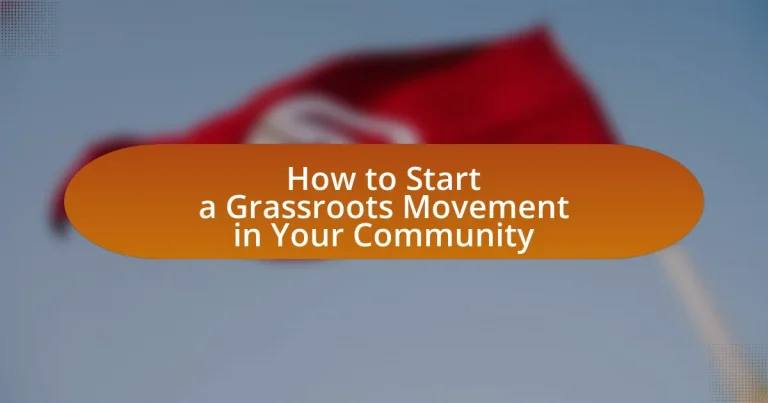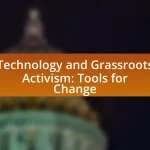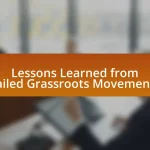A grassroots movement is a community-driven initiative aimed at enacting social or political change, primarily led by ordinary individuals rather than established organizations. This article outlines the essential steps to start a grassroots movement, including identifying local issues, building a core team, and engaging community members through effective communication and outreach strategies. It emphasizes the importance of community participation, the characteristics that define grassroots movements, and the common goals they pursue, such as promoting social justice and empowering marginalized groups. Additionally, the article discusses potential challenges, funding opportunities, and best practices for sustaining momentum and achieving long-term impact within the community.
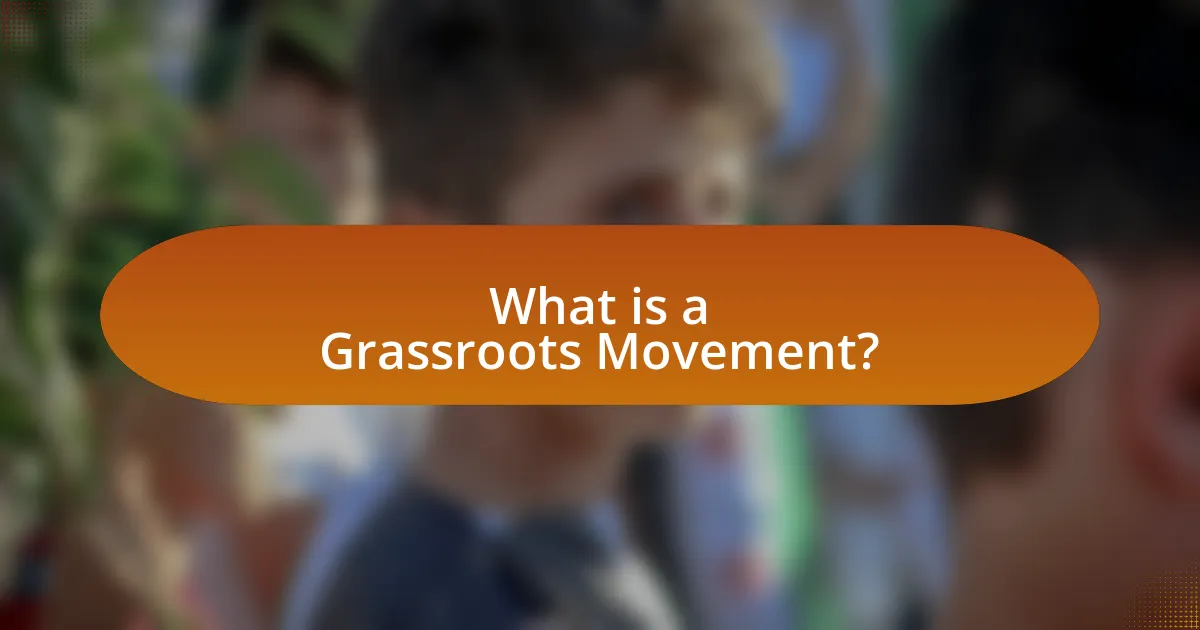
What is a Grassroots Movement?
A grassroots movement is a collective effort initiated by ordinary people at the community level to bring about social or political change. These movements often arise from local concerns and are characterized by their bottom-up approach, where individuals mobilize to advocate for issues that directly affect them. Historical examples include the Civil Rights Movement in the United States, which was largely driven by grassroots activism, demonstrating the effectiveness of community-driven efforts in influencing policy and societal norms.
How does a grassroots movement differ from other types of movements?
A grassroots movement differs from other types of movements primarily in its origin and structure, as it is initiated and driven by ordinary people at the community level rather than by established organizations or leaders. Grassroots movements typically focus on local issues and rely on collective action, emphasizing community participation and engagement to effect change. For example, the Civil Rights Movement in the United States saw grassroots efforts led by local activists, which contrasted with top-down approaches often seen in political parties or large organizations. This bottom-up approach fosters a sense of ownership among participants, making grassroots movements more adaptable and responsive to the specific needs of the community they represent.
What are the key characteristics of grassroots movements?
Grassroots movements are characterized by their community-driven nature, emphasizing local participation and collective action. These movements typically arise from the needs and concerns of ordinary people rather than top-down directives from established organizations or authorities. They often focus on social, political, or environmental issues that directly affect the community, fostering a sense of ownership and empowerment among participants.
Additionally, grassroots movements rely on informal networks and grassroots organizing strategies, utilizing social media and local gatherings to mobilize support and spread awareness. Historical examples, such as the Civil Rights Movement in the United States, illustrate how grassroots efforts can lead to significant societal change, demonstrating the effectiveness of community engagement in advocating for justice and reform.
Why are grassroots movements important in community change?
Grassroots movements are important in community change because they empower individuals to collectively address local issues and influence decision-making processes. These movements often arise from the community’s direct experiences and needs, fostering a sense of ownership and responsibility among participants. For example, the Civil Rights Movement in the United States demonstrated how grassroots organizing can lead to significant legislative changes, such as the Civil Rights Act of 1964, which was driven by community-led efforts advocating for equality and justice. This illustrates that grassroots movements not only mobilize community members but also create lasting impacts on policies and social norms.
What are the common goals of grassroots movements?
Common goals of grassroots movements include promoting social change, advocating for community needs, and empowering marginalized groups. These movements often aim to influence policy decisions at local, state, or national levels by mobilizing community members and raising awareness about specific issues. For instance, the Civil Rights Movement in the United States sought to end racial segregation and discrimination, demonstrating how grassroots efforts can lead to significant legislative changes, such as the Civil Rights Act of 1964.
How do grassroots movements address local issues?
Grassroots movements address local issues by mobilizing community members to advocate for change and implement solutions that reflect their specific needs. These movements often begin with identifying a local problem, such as environmental concerns or social injustices, and then organizing residents to raise awareness, gather support, and influence decision-makers. For example, the community-led initiative “Stop the Spray” in New York City successfully mobilized residents against pesticide spraying in public spaces, demonstrating how grassroots efforts can lead to policy changes that prioritize community health. This approach not only empowers individuals but also fosters a sense of ownership and responsibility towards local issues, ultimately driving sustainable change.
What social changes do grassroots movements typically aim for?
Grassroots movements typically aim for social changes that promote equity, justice, and community empowerment. These movements often focus on issues such as environmental protection, social justice, civil rights, and political reform. For instance, the Civil Rights Movement in the United States sought to end racial segregation and discrimination, leading to significant legislative changes like the Civil Rights Act of 1964. Additionally, grassroots efforts like the climate justice movement advocate for sustainable practices and policies to combat climate change, reflecting a growing public demand for environmental accountability. These examples illustrate how grassroots movements effectively mobilize communities to address systemic issues and drive meaningful social change.
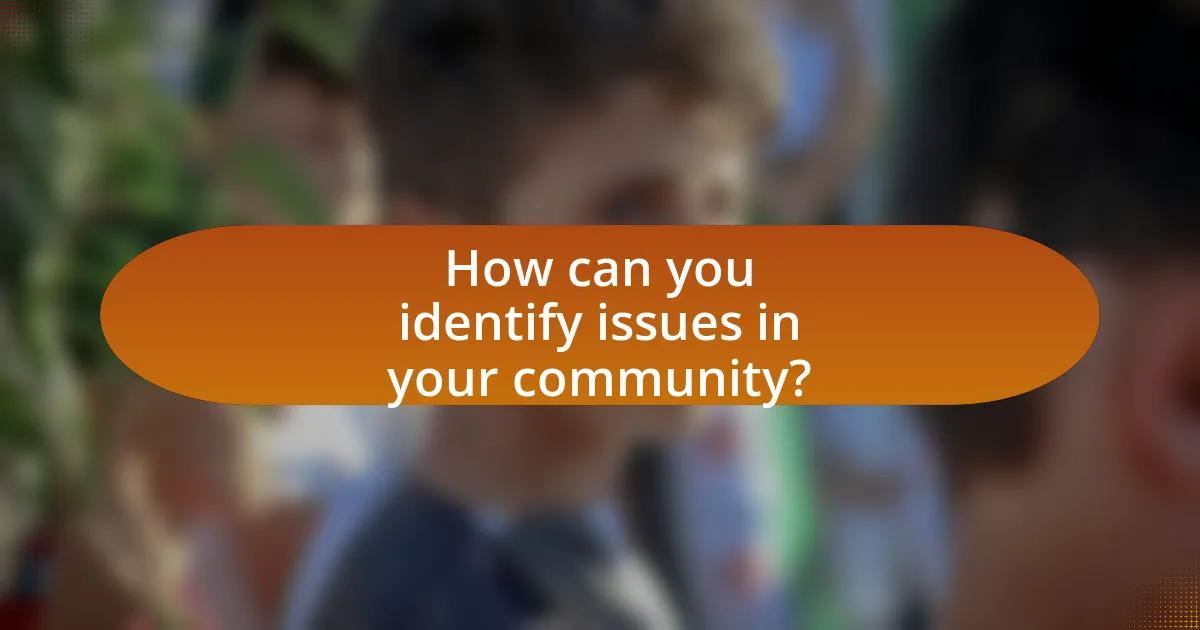
How can you identify issues in your community?
To identify issues in your community, conduct surveys and engage in conversations with residents to gather their concerns and experiences. This method allows for direct feedback and highlights prevalent issues such as crime rates, lack of public services, or environmental concerns. According to a 2020 study by the Pew Research Center, 65% of community members reported feeling more connected and informed when they participated in local discussions, indicating that active engagement is crucial for identifying community issues effectively.
What methods can you use to assess community needs?
To assess community needs, you can use methods such as surveys, focus groups, community forums, and interviews. Surveys allow for the collection of quantitative data from a larger population, providing insights into community priorities and concerns. Focus groups facilitate in-depth discussions among a small group of participants, revealing qualitative insights into specific issues. Community forums encourage open dialogue among residents, fostering a sense of involvement and collaboration. Interviews with key stakeholders can provide detailed perspectives on community needs. These methods are effective as they engage community members directly, ensuring that the assessment reflects the actual needs and desires of the population.
How can surveys and interviews help in identifying issues?
Surveys and interviews are effective tools for identifying issues within a community by gathering direct feedback from its members. These methods allow for the collection of qualitative and quantitative data, revealing specific concerns, needs, and priorities of the population. For instance, a survey can quantify the prevalence of a particular issue, while interviews can provide deeper insights into personal experiences and perspectives. Research indicates that community engagement through surveys and interviews leads to more accurate identification of local problems, as evidenced by a study published in the Journal of Community Psychology, which found that participatory methods significantly enhance understanding of community dynamics and challenges.
What role do community meetings play in issue identification?
Community meetings play a crucial role in issue identification by providing a platform for residents to voice concerns and share experiences. These gatherings facilitate open dialogue, allowing community members to collectively identify and prioritize local issues based on shared interests and needs. Research indicates that participatory approaches, such as community meetings, enhance the identification of pressing issues, as they encourage diverse perspectives and foster a sense of ownership among participants. For instance, a study by the National Civic League found that communities engaging in regular meetings reported a 30% increase in the identification of local issues compared to those that did not.
Why is community engagement crucial for a grassroots movement?
Community engagement is crucial for a grassroots movement because it fosters collective action and builds a sense of ownership among participants. When individuals in a community actively engage, they contribute their perspectives, skills, and resources, which enhances the movement’s effectiveness and sustainability. Research indicates that grassroots movements with strong community involvement are more likely to achieve their goals; for instance, the 2011 Occupy Wall Street movement demonstrated that local engagement led to widespread support and visibility, ultimately influencing public discourse on economic inequality. This illustrates that community engagement not only mobilizes resources but also strengthens the movement’s legitimacy and impact.
How can you effectively engage community members?
To effectively engage community members, initiate open communication channels that encourage participation and feedback. Research indicates that communities with strong communication strategies see a 30% increase in member involvement. Utilize social media platforms, community meetings, and surveys to gather input and foster dialogue. This approach not only builds trust but also empowers members to contribute ideas and solutions, enhancing their sense of ownership in community initiatives.
What strategies can foster a sense of ownership among participants?
Empowering participants through active involvement fosters a sense of ownership among them. Strategies include encouraging collaboration in decision-making processes, which allows participants to contribute their ideas and feel valued. Providing opportunities for leadership roles within the movement enhances their commitment and investment. Additionally, recognizing and celebrating individual contributions reinforces their importance to the group. Research indicates that when individuals feel their input is acknowledged, their emotional and psychological investment in the initiative increases, leading to a stronger sense of ownership.
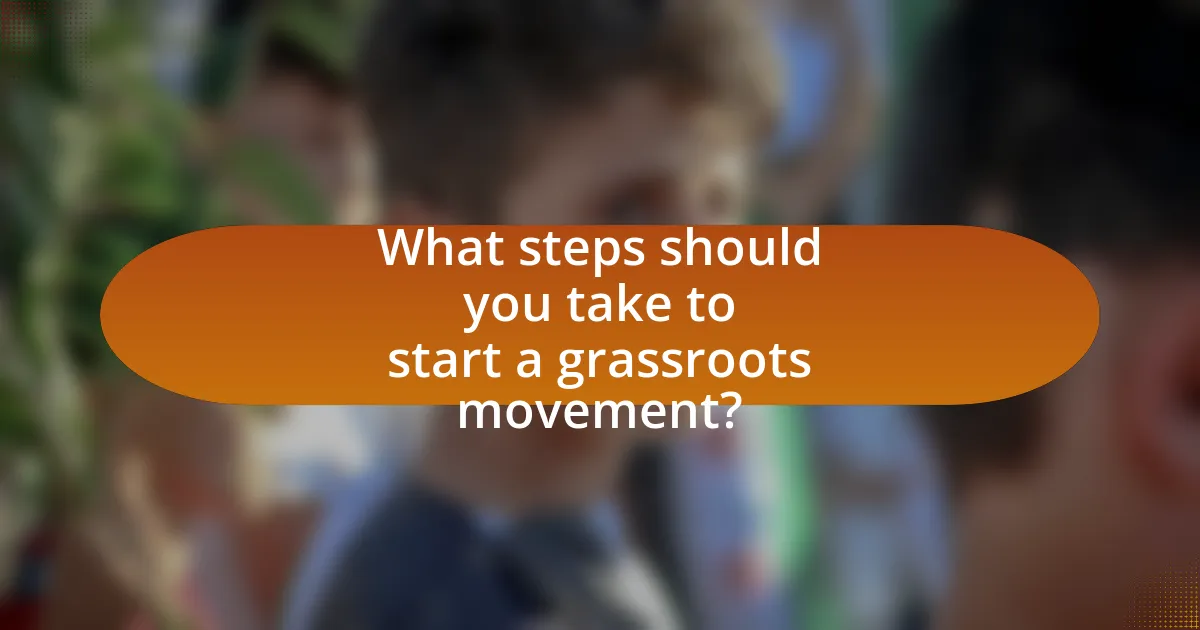
What steps should you take to start a grassroots movement?
To start a grassroots movement, first identify a clear and compelling issue that resonates with your community. This involves researching local concerns and gathering data to understand the community’s needs and interests. Next, build a core team of passionate individuals who share your vision and can help mobilize support. Organize meetings to brainstorm strategies and establish goals for the movement.
Then, create a communication plan that utilizes social media, local events, and community forums to raise awareness and engage potential supporters. Mobilize volunteers to participate in outreach efforts, such as canvassing or hosting informational sessions. Additionally, establish partnerships with local organizations and stakeholders to amplify your message and resources.
Finally, monitor progress and adapt strategies based on feedback and changing circumstances to ensure the movement remains relevant and effective. Historical examples, such as the Civil Rights Movement, demonstrate that grassroots efforts can lead to significant social change when organized effectively.
How do you build a core team for your movement?
To build a core team for your movement, identify individuals who share your vision and values. Start by recruiting passionate and committed members from your community who possess diverse skills relevant to your movement’s goals, such as organizing, communication, and fundraising. Engage these individuals through meetings and discussions to foster collaboration and establish clear roles and responsibilities. Research indicates that successful grassroots movements often rely on a strong core team to drive initiatives and maintain momentum, as seen in the Civil Rights Movement, where dedicated leaders like Martin Luther King Jr. mobilized support and coordinated efforts effectively.
What qualities should you look for in team members?
When selecting team members for a grassroots movement, look for qualities such as passion, commitment, collaboration, and adaptability. Passion drives individuals to invest time and energy into the cause, while commitment ensures they remain engaged through challenges. Collaboration is essential for effective teamwork, as it fosters diverse ideas and solutions. Adaptability allows team members to respond to changing circumstances and feedback, which is crucial in dynamic community environments. These qualities collectively enhance the effectiveness and resilience of the grassroots movement.
How can you establish roles and responsibilities within the team?
To establish roles and responsibilities within the team, clearly define each member’s tasks based on their skills and interests. This can be achieved through initial discussions where team members express their strengths and preferences, allowing for a more tailored assignment of roles. Research indicates that teams with well-defined roles experience a 20% increase in productivity, as noted in a study by Hackman and Oldham (1976) on job characteristics and team effectiveness. By aligning roles with individual capabilities, the team can operate more efficiently and effectively towards common goals.
What strategies can you use to raise awareness?
To raise awareness, utilize social media campaigns, community events, and partnerships with local organizations. Social media campaigns can effectively reach a broad audience; for instance, platforms like Facebook and Instagram have billions of active users, allowing for targeted messaging. Organizing community events, such as workshops or informational sessions, fosters direct engagement and personal connections, which can enhance understanding and support. Collaborating with local organizations leverages existing networks and resources, amplifying the message and increasing credibility. According to a study by the Pew Research Center, 69% of adults in the U.S. use social media, highlighting its potential as a powerful tool for awareness-raising initiatives.
How can social media be leveraged for outreach?
Social media can be leveraged for outreach by creating targeted campaigns that engage specific audiences and promote community involvement. Platforms like Facebook, Twitter, and Instagram allow grassroots movements to share information, mobilize supporters, and foster discussions around local issues. For instance, a study by Pew Research Center indicates that 69% of adults in the U.S. use social media, making it an effective tool for reaching a broad demographic. Additionally, social media enables real-time communication, allowing organizations to respond quickly to community needs and events, thereby enhancing engagement and participation.
What traditional methods can complement digital outreach?
Traditional methods that can complement digital outreach include community events, flyers, and door-to-door canvassing. Community events, such as town hall meetings or local festivals, facilitate face-to-face interactions, fostering personal connections and trust among participants. Flyers distributed in high-traffic areas or local businesses effectively reach audiences who may not engage online, ensuring broader visibility. Door-to-door canvassing allows for direct engagement with community members, providing opportunities for personalized conversations and immediate feedback. These methods have been shown to enhance the effectiveness of digital campaigns by creating a multi-channel approach that increases overall outreach and engagement.
How do you create a clear message for your movement?
To create a clear message for your movement, define your core values and objectives succinctly. This involves identifying the primary issue your movement addresses and articulating it in simple, relatable language that resonates with your target audience. For example, the civil rights movement effectively communicated its message through slogans like “Black Lives Matter,” which encapsulated the struggle for equality and justice. Clear messaging enhances understanding and mobilizes support, as evidenced by studies showing that movements with concise, focused messages attract more participants and media attention.
What elements should be included in your movement’s mission statement?
A movement’s mission statement should include a clear purpose, target audience, core values, and specific goals. The purpose articulates the reason for the movement’s existence, while the target audience identifies who the movement aims to serve or influence. Core values reflect the principles guiding the movement’s actions and decisions, and specific goals outline measurable outcomes the movement seeks to achieve. For example, the mission statement of the civil rights movement emphasized equality, justice, and the empowerment of marginalized communities, which effectively communicated its objectives and attracted support.
How can storytelling enhance your movement’s message?
Storytelling can enhance a movement’s message by creating emotional connections that resonate with the audience. When individuals share personal narratives related to the movement’s cause, it humanizes the issue and fosters empathy, making the message more relatable and impactful. Research indicates that stories activate the brain’s mirror neurons, which can lead to increased engagement and motivation among listeners. For example, a study published in the journal “Psychological Science” found that narratives can significantly influence attitudes and behaviors, demonstrating the power of storytelling in advocacy and mobilization efforts.
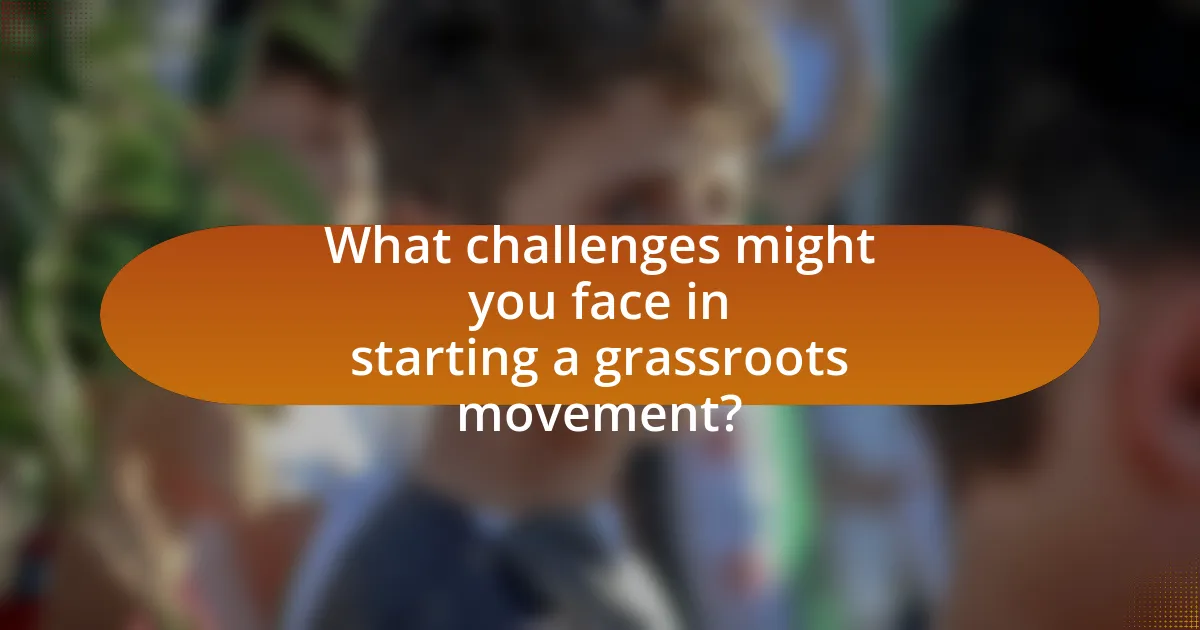
What challenges might you face in starting a grassroots movement?
Starting a grassroots movement may face challenges such as limited funding, lack of visibility, and difficulty in mobilizing community support. Limited funding restricts resources for outreach and activities, making it hard to gain traction. A lack of visibility can hinder awareness and engagement, as potential supporters may not know about the movement’s goals or existence. Additionally, mobilizing community support can be challenging due to differing priorities among community members, resistance to change, or apathy towards the cause. These factors can significantly impede the effectiveness and growth of a grassroots initiative.
How can you overcome resistance from local authorities?
To overcome resistance from local authorities, engage in open dialogue and build relationships with key decision-makers. Establishing trust through consistent communication and demonstrating the benefits of your grassroots movement can alleviate concerns. For instance, presenting data that shows community support or potential economic benefits can persuade local authorities to reconsider their stance. Research indicates that collaborative approaches, such as involving local officials in planning processes, often lead to more favorable outcomes, as seen in successful community initiatives across various regions.
What strategies can help in negotiating with officials?
Effective strategies for negotiating with officials include thorough preparation, establishing rapport, and presenting clear, evidence-based arguments. Preparation involves researching the official’s background, interests, and previous decisions to tailor the negotiation approach. Establishing rapport can facilitate a more open dialogue, making officials more receptive to proposals. Presenting clear, evidence-based arguments, supported by data or case studies, enhances credibility and persuades officials by demonstrating the benefits of the proposed initiatives. For instance, a study by the Harvard Negotiation Project emphasizes the importance of understanding the interests of both parties to reach mutually beneficial outcomes.
How can you build alliances with other organizations?
To build alliances with other organizations, initiate open communication to identify shared goals and values. Establishing a mutual understanding fosters collaboration, as evidenced by successful partnerships in community initiatives where organizations align their missions, such as the collaboration between the American Red Cross and local health departments during disaster response efforts. Engaging in joint projects or events can further solidify these alliances, demonstrating commitment and enhancing visibility for all parties involved.
What are common pitfalls to avoid when starting a grassroots movement?
Common pitfalls to avoid when starting a grassroots movement include lack of clear goals, insufficient community engagement, and failure to build a diverse coalition. Clear goals are essential; without them, efforts can become unfocused, leading to wasted resources and diminished impact. Insufficient community engagement can alienate potential supporters, as grassroots movements thrive on local involvement and shared ownership. Additionally, failing to build a diverse coalition can limit perspectives and reduce the movement’s reach, as diverse groups bring varied experiences and ideas that strengthen advocacy efforts. Research shows that movements with clear objectives and broad participation are more successful in achieving their aims.
How can lack of organization hinder your efforts?
Lack of organization can significantly hinder your efforts in starting a grassroots movement by causing confusion, inefficiency, and missed opportunities. When a movement lacks structure, participants may not understand their roles or responsibilities, leading to duplicated efforts or tasks being overlooked. Research indicates that organized groups are 50% more likely to achieve their goals compared to disorganized ones, as clear communication and defined objectives enhance collaboration and effectiveness. Without organization, resources may be wasted, timelines can be extended, and the overall impact of the movement may diminish, ultimately reducing community engagement and support.
What impact does poor communication have on movement success?
Poor communication significantly hinders movement success by creating misunderstandings and reducing participant engagement. When individuals involved in a grassroots movement lack clear and effective communication, it leads to confusion regarding goals, strategies, and roles, ultimately diminishing collective action. Research indicates that effective communication is crucial for mobilizing support; for instance, a study published in the Journal of Community Psychology found that movements with strong communication strategies were 50% more likely to achieve their objectives compared to those with poor communication. This evidence underscores the necessity of clear messaging and open dialogue to foster unity and drive momentum in grassroots initiatives.
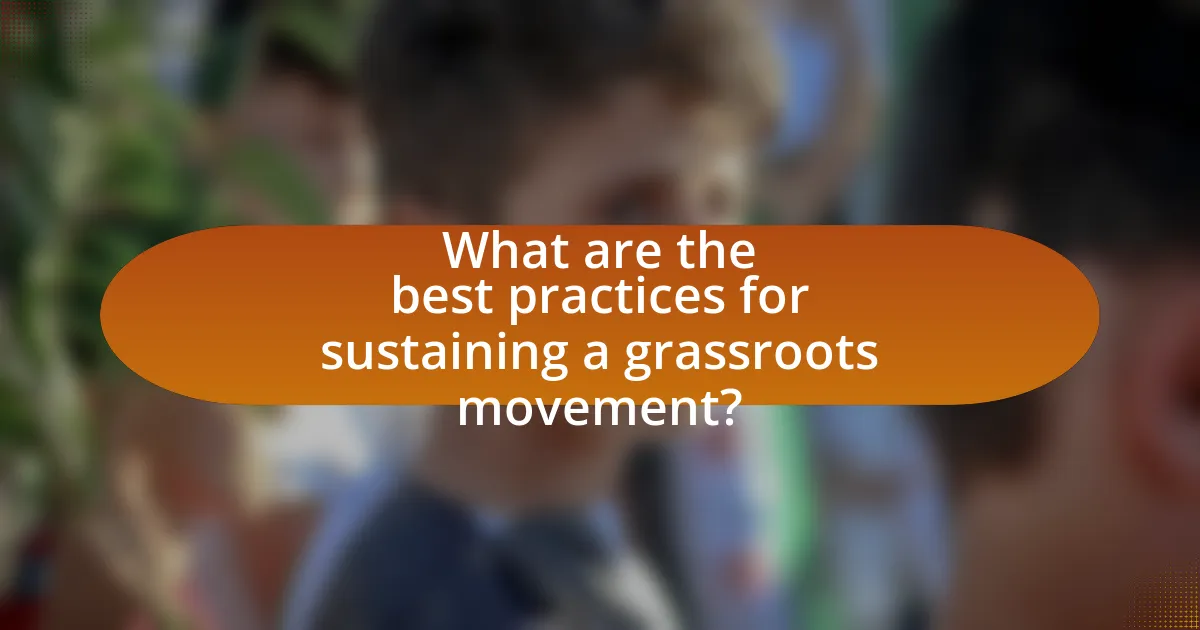
What are the best practices for sustaining a grassroots movement?
The best practices for sustaining a grassroots movement include building strong community relationships, maintaining clear communication, and ensuring consistent engagement. Strong community relationships foster trust and collaboration, which are essential for long-term support. Clear communication keeps all members informed and aligned with the movement’s goals, while consistent engagement through events and outreach activities helps maintain momentum. Research indicates that grassroots movements with high levels of community involvement and effective communication strategies are more likely to achieve their objectives and sustain their efforts over time. For example, the Civil Rights Movement in the United States successfully utilized these practices to mobilize support and effect change.
How can you maintain momentum over time?
To maintain momentum over time in a grassroots movement, consistently engage and mobilize community members through regular communication and events. This approach fosters a sense of belonging and shared purpose, which is crucial for sustaining interest and participation. Research indicates that movements with ongoing activities and clear communication strategies are more likely to retain active supporters; for example, the “Mobilization Theory” highlights the importance of continuous engagement in maintaining participant commitment.
What role does continuous engagement play in sustainability?
Continuous engagement is crucial for sustainability as it fosters ongoing participation and commitment from community members. This consistent involvement helps to build trust, enhance collaboration, and ensure that sustainability initiatives are effectively implemented and maintained over time. Research indicates that communities with high levels of engagement are more likely to achieve long-term sustainability goals, as evidenced by a study published in the Journal of Environmental Management, which found that active community participation significantly improved project outcomes and resource management.
How can you celebrate small victories to motivate participants?
Celebrating small victories can motivate participants by recognizing their achievements and reinforcing positive behavior. Implementing regular acknowledgment, such as shout-outs during meetings or social media posts, fosters a sense of community and belonging. Research indicates that recognition can enhance motivation and engagement, as seen in a study by the Harvard Business Review, which found that employees who receive regular praise are more productive and committed. Additionally, organizing small rewards or team celebrations for milestones can create a positive feedback loop, encouraging continued participation and effort.
What resources are available to support grassroots movements?
Grassroots movements can access various resources to enhance their efforts, including funding opportunities, training programs, and networking platforms. Organizations like the Grassroots Fund provide financial support specifically for community-led initiatives, while training resources from groups such as the Center for Community Change offer workshops on organizing and advocacy skills. Additionally, platforms like Meetup and social media networks facilitate connections among activists, allowing for collaboration and sharing of best practices. These resources collectively empower grassroots movements to mobilize effectively and achieve their goals.
How can local nonprofits assist in your efforts?
Local nonprofits can assist in your efforts by providing resources, expertise, and community connections essential for grassroots movements. They often have established networks that can amplify your message and mobilize volunteers. For example, nonprofits frequently possess experience in advocacy, fundraising, and community organizing, which can enhance the effectiveness of your initiatives. Additionally, according to a report by the National Council of Nonprofits, 90% of nonprofits engage in community outreach, making them valuable partners in reaching diverse populations and fostering community engagement.
What funding opportunities exist for grassroots initiatives?
Funding opportunities for grassroots initiatives include grants from foundations, crowdfunding platforms, and local government funding. Foundations such as the Ford Foundation and the Rockefeller Foundation provide grants specifically aimed at supporting community-driven projects. Crowdfunding platforms like GoFundMe and Kickstarter allow individuals to raise money directly from the public for their initiatives. Additionally, many local governments offer funding through community development programs to support grassroots efforts that address local needs. These funding sources are essential for enabling grassroots movements to launch and sustain their activities effectively.
What practical tips can help you successfully start a grassroots movement?
To successfully start a grassroots movement, begin by clearly defining your cause and objectives. This clarity helps in mobilizing support and resources effectively. Engage your community by organizing meetings to discuss the issue, gather input, and build a coalition of like-minded individuals. Utilize social media platforms to spread awareness and connect with a broader audience, as studies show that 70% of grassroots movements leverage social media for outreach. Establish a strong narrative that resonates emotionally with potential supporters, as compelling stories can drive engagement and action. Finally, create actionable steps for supporters to take, such as signing petitions or attending events, to foster a sense of participation and urgency.
